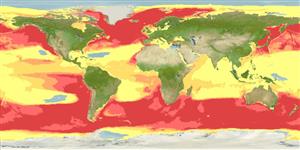Common names from other countries
Classification / Names / Names
Namen | Synonyme | Catalog of Fishes (gen., sp.) | ITIS | CoL | WoRMS
Environment: milieu / climate zone / depth range / distribution range
Ökologie
Pelagisch; ozeanodrom (Ref. 75906); tiefenbereich 0 - 230 m (Ref. 1005). Tropical; 90°N - 90°S, 180°W - 180°E
Circumglobal except the Arctic: Balaenoptera physalus physalus: Svalbard, Barents Sea, North Carolina, Portugal, Cantabrian Sea, Newfoundland, Gulf of Mexico, Greater Antilles, Faroe Islands, Norway, Canary Islands, Sea of Okhotsk, Kuril Islands, Bering Sea, Chukchi Sea, Gulf of Alaska, Sea of Japan, Japan, Taiwan, Ogasawara, Hawaii, California, Baja California, Gulf of California; Balaenoptera physalus quoyi: Ross Ice Shelf, Brazil, Gabon, Angola, Namibia, South Africa, Madagascar, Western Australia, New Zealand, Colombia, Peru, Chile (Ref. 1522).
Length at first maturity / Size / Gewicht / Alter
Maturity: Lm ? range ? - ? cm Max length : 2,700 cm TL Männchen/unbestimmt; (Ref. 1394); max. veröff. Gewicht: 75.0 t (Ref. 1394)
The largest of the fin whales. Seen near shore, most commonly where deep water approaches the coast. Feeds on small invertebrates, schooling fishes, and squid. They are active lunge feeders (Ref. 1394). They are preyed upon by great white sharks (Ref. 32140). Following depletion of blue whale stocks, whalers shifted their attention to fin whales. Populations everywhere were substantially reduced. At present the worldwide population does not seem to appear in any immediate danger (Ref. 1394). Minimum depth from Ref. 116169.
Jefferson, T.A., S. Leatherwood and M.A. Webber. 1993. (Ref. 1394)
IUCN Rote Liste Status (Ref. 130435: Version 2024-1)
CITES Status (Ref. 108899)
Nutzung durch Menschen
Fischereien: kommerziell
FAO - Fischereien: landings, Artbeschreibung | FishSource | Sea Around Us
Tools
Internet Quellen
Estimates based on models
Preferred temperature
(Ref.
115969): 0.2 - 4.6, mean 1.5 (based on 25596 cells).
Widerstandsfähigkeit
mittel, Verdopplung der Population dauert 1,4 - 4,4 Jahre. (K=0.25-0.27; tm=17.5).
Verwundbarkeit
Very high vulnerability (76 of 100).
Preiskategorie
Unknown.
